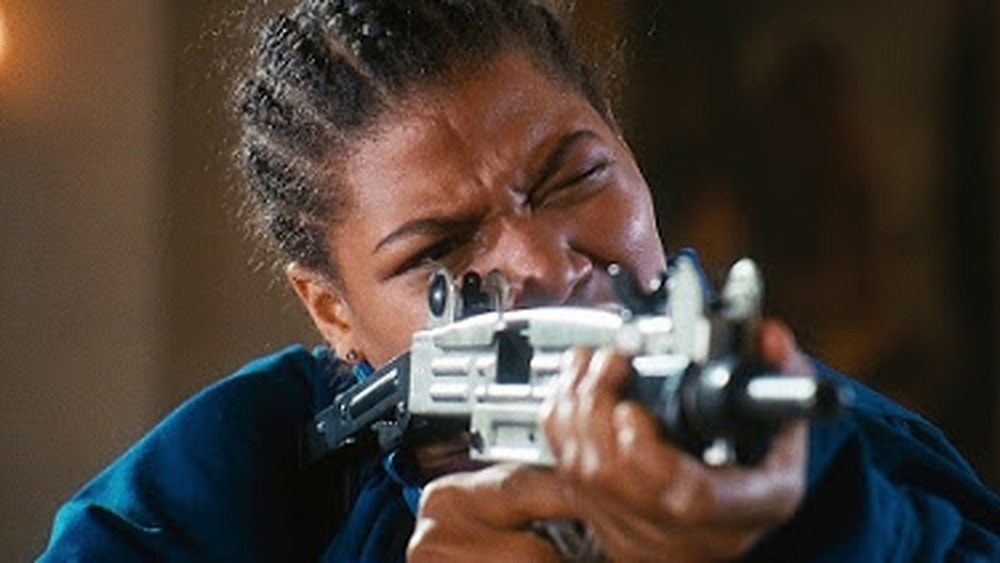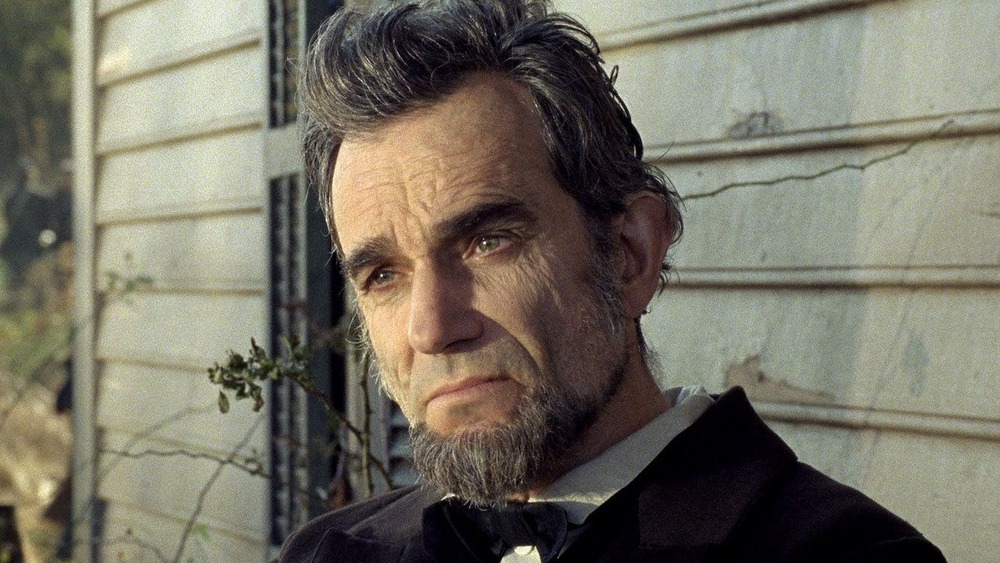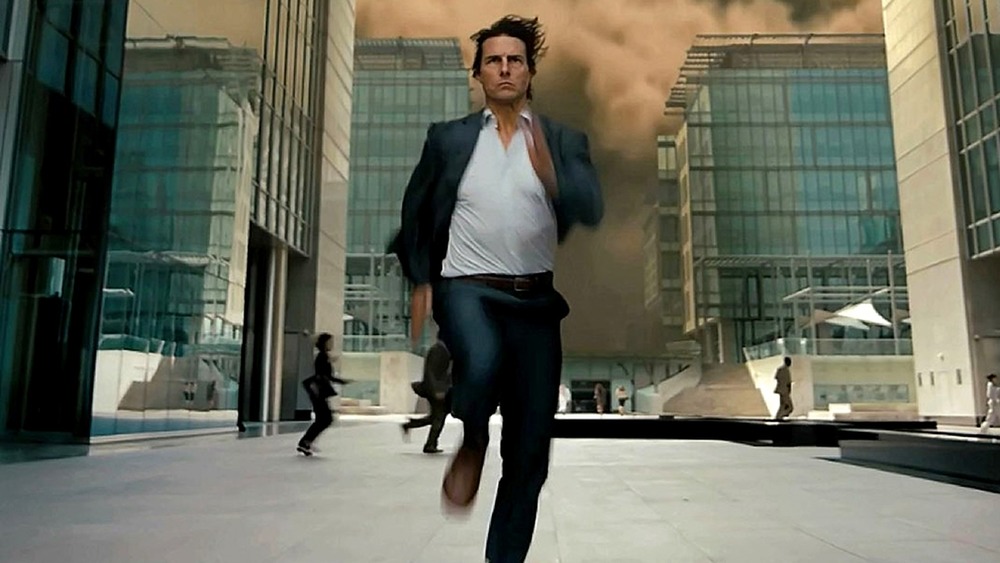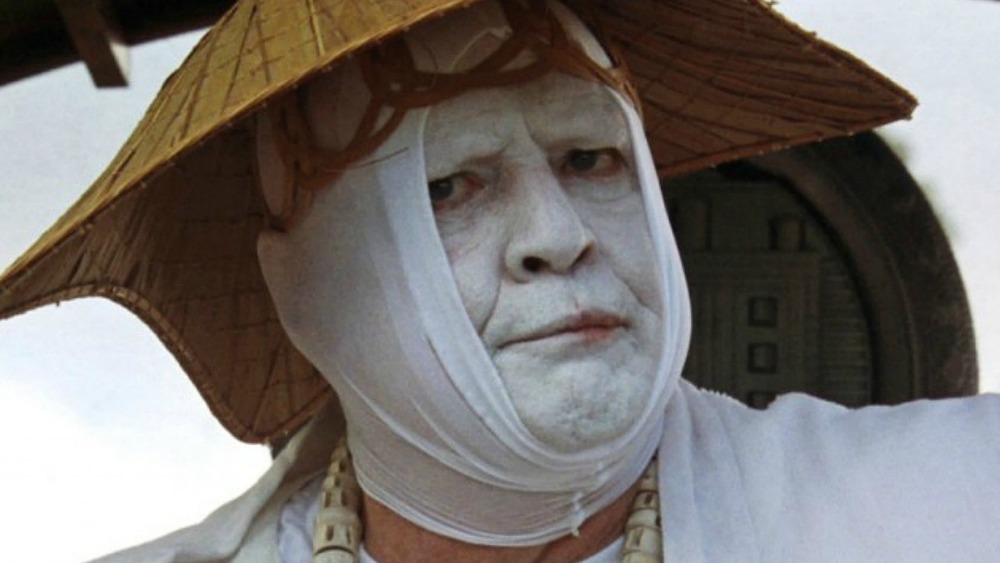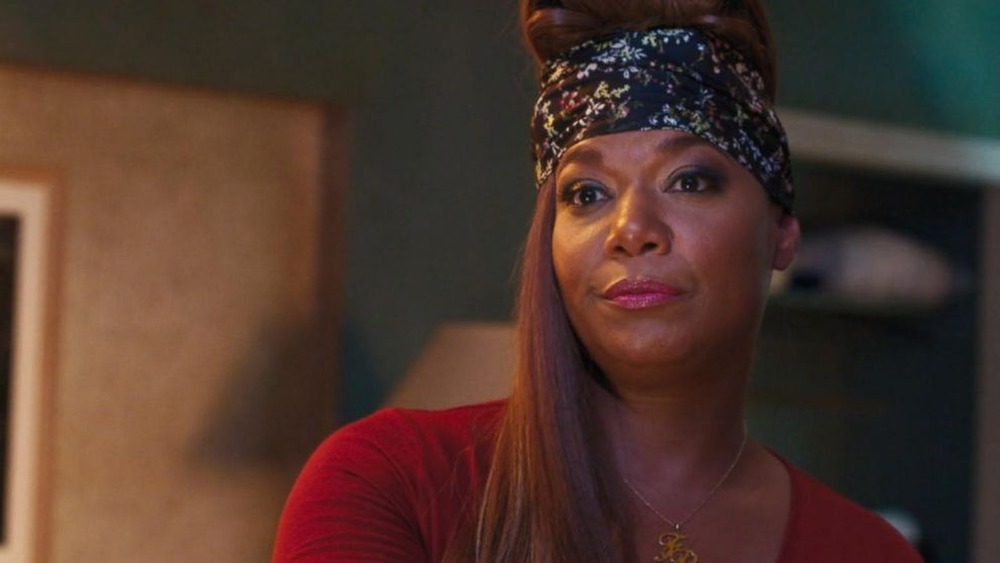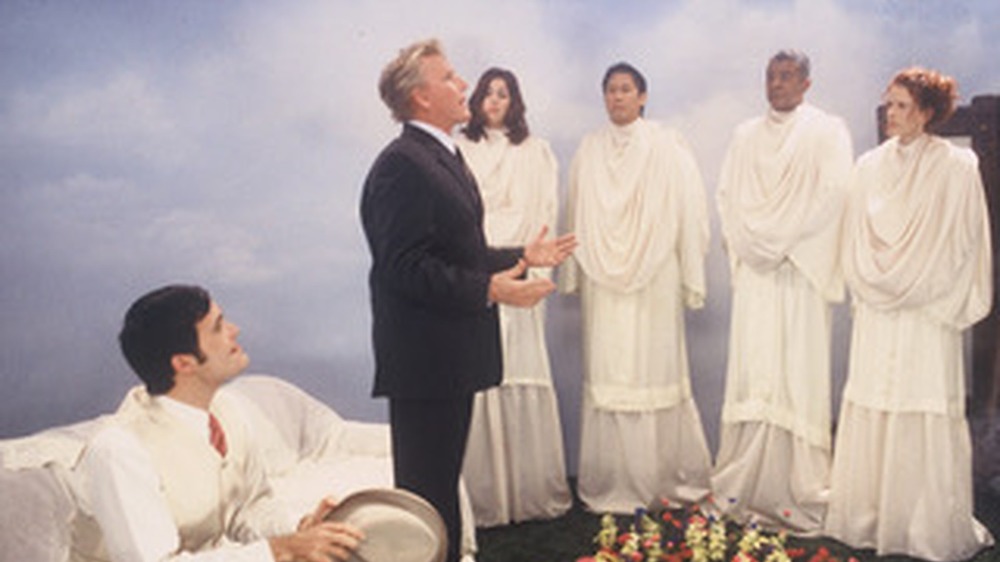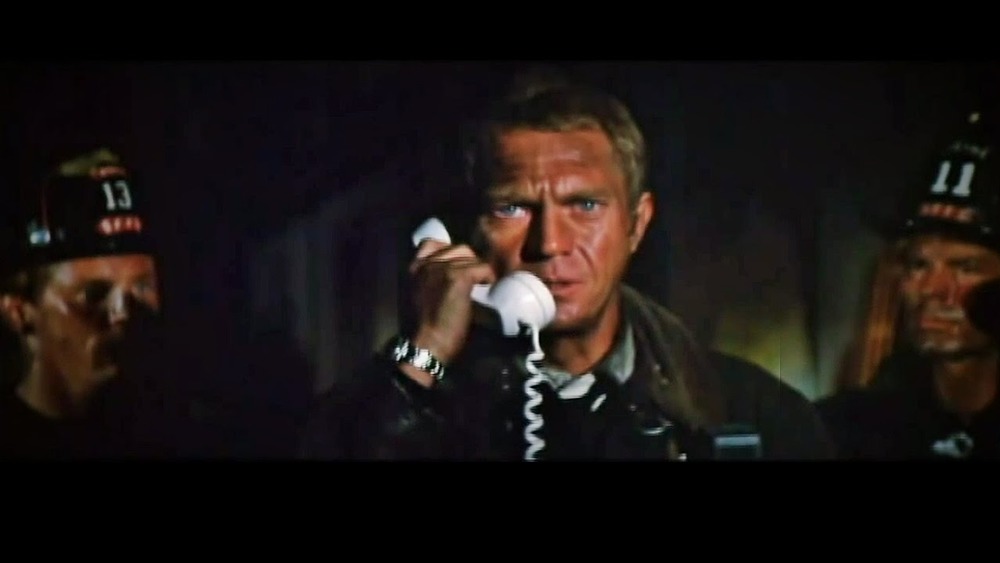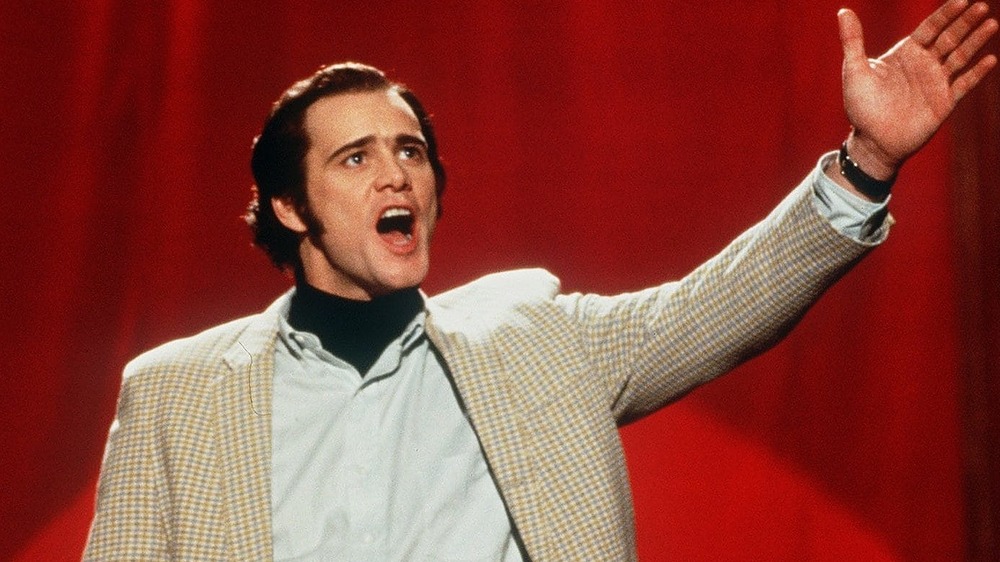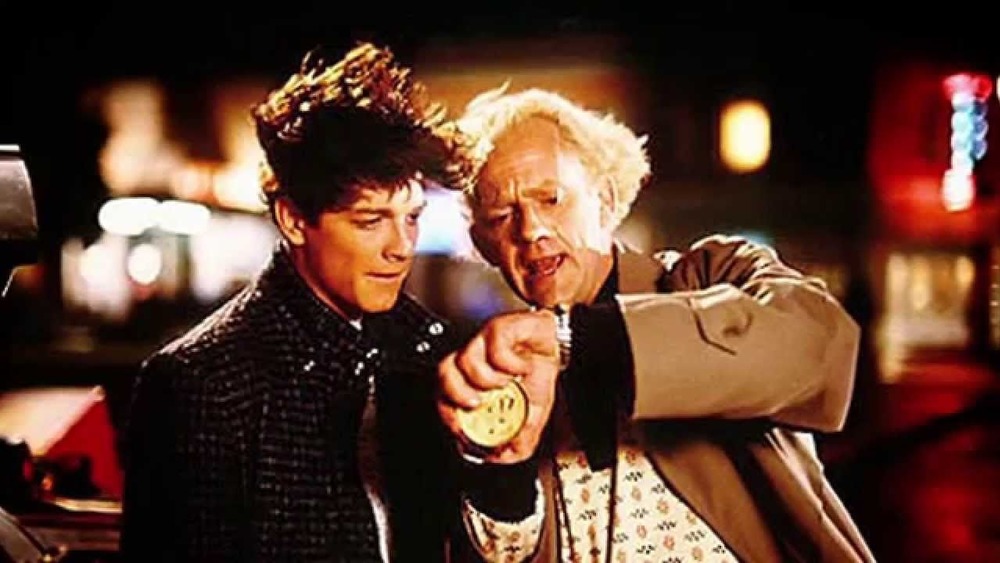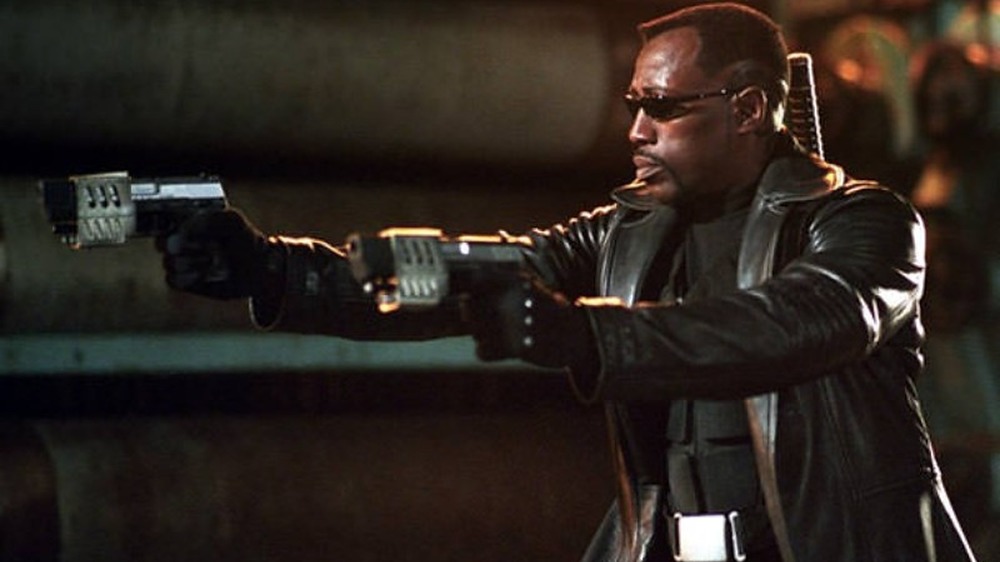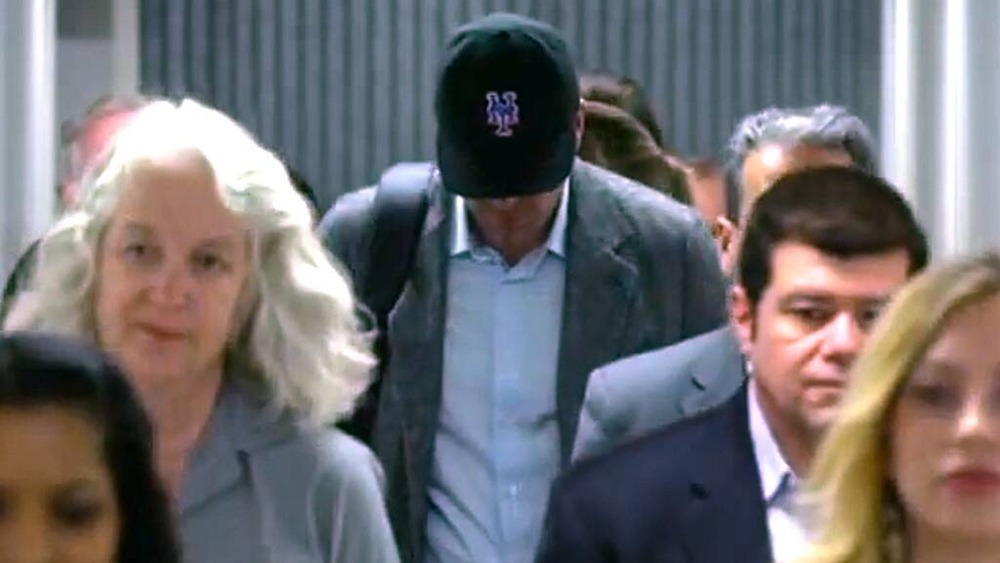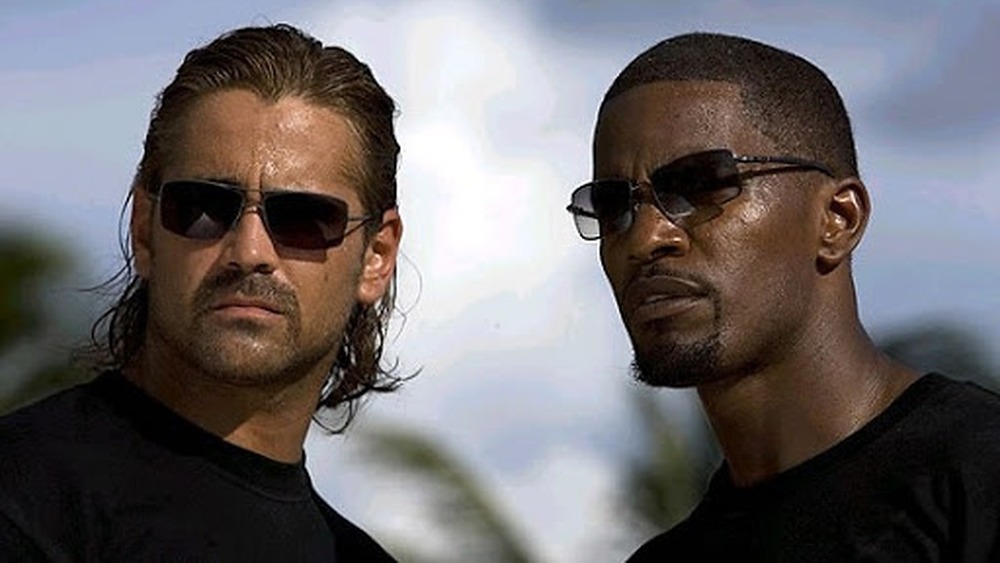Rules Actors Make Others Follow On Movie Sets
What would you do for the chance to meet your favorite actor? Many of us would probably go out of our way for the opportunity. If we think about it that way, perhaps we can understand what gives so many stars the prerogative to make seemingly outrageous demands on set. You probably shouldn't look a gift horse in the mouth, right? But what if the gift horse is demanding that you only communicate via Post-It Note on set?
Some actors make demands that require a lot of crew members or co-stars, to the point of making them uncomfortable or adding unnecessary work or production days. This can have ramifications as simple as lowering morale for a while on set ... or as significant as massively increasing the cost of the project they're working on. Other actors' requests aren't especially inconvenient or selfish — they're just downright strange. They all have one thing in common, though, and that's the fact that they make for pretty interesting stories. These are the weirdest, funniest, and most complicated rules actors make others follow on set.
A hard Day-Lewis's work
Daniel Day-Lewis thought, when he accepted the titular part in Steven Spielberg's 2012 biopic Lincoln, that it was a "very, very bad idea." The decorated performer is famous for method acting and being selective about the roles he plays. He goes to great lengths to fully inhabit his characters — lengths that sometimes alienate not only the cast and crew around him, but even those he knows personally.
In the case of Lincoln, Day-Lewis spent about a year studying the 16th president's own writings, in addition to other sources, including photographs. The actor looked at them "the way you sometimes look at your own reflection in the mirror and wonder who that person is looking back at you." This should be a pretty good clue as to how Day-Lewis' characteristic method acting panned out: Essentially, the actor convinced himself he was Lincoln.
Of course, President Abraham Lincoln wouldn't condescend to be addressed by any name other than his own. So Spielberg referred to Day-Lewis, and the entire cast, by their characters' names throughout the entirety of filming. He also asked the actor playing Ulysses S. Grant, Jared Harris, not to speak in his natural British accent, so as not to throw off Day-Lewis' rhythm. So not only was Day-Lewis in character the entire time to preserve the integrity of his method acting, he required the same from others, too.
Lindsay Lohan gets naked and unafraid
On the set of an erotic thriller, it's conceivable that some participants might show up with a few reservations. This was definitely the case for Lindsay Lohan in one particular scene of Paul Schrader's 2013 film The Canyons, in which she starred opposite adult film actor James Deen.
Lohan was uncomfortable with the expectation of shooting a semi-nude sex scene during the film, and initially refused to go topless for the camera. But as the age-old stage fright advice tells us, if we're nervous, we should just imagine everyone in their underwear. This way, everyone is equally vulnerable, and the playing field is leveled as we approach a potentially embarrassing moment. Stripped down, the compromised audience doesn't really have the latitude to judge us, do they?
Lohan took imagination one step further, and actually asked all 10 members of the crew to strip down first. As crazy as actor rules and requests like these may be, sometimes, they're the only way to make it to wrap — even if they first require a little unwrapping.
Tom Cruise's run and only
Tom Cruise frequently takes on the challenge of performing his own stunts. The simple act of running might not seem to qualify as a stunt at all, next to the underwater sequence from 2015's Mission Impossible: Rogue Nation, or Cruise's skydive into Paris at the opening of Mission Impossible: Fallout in 2018. That one took 106 jumps to capture, all of which Cruise completed with a broken ankle. But you'd be surprised at how intense running can be.
The way Cruise approaches running isn't quite like anyone else. For one thing, he keeps dozens of thongs ready on set when he has to film a sprinting scene, because of the comfort and flexibility they offer. He takes his running so seriously that, unlike even his skydiving, this "stunt" belongs to him alone: Cruise has a hard-and-fast (emphasis on fast) rule that no one is allowed to run alongside him. The Mummy co-star Annabelle Wallis claims that she is the only person for whom he has ever made an exception, timing her treadmill workouts so that he would walk in and see what a capable runner she was and include her in running scenes in the 2017 film.
Viewers have pointed out that he has run alongside other actors in some films, however, as happens in Jack Reacher: Never Go Back. But for most of his films, he holds fast to his rule, and the other actors on set are bound to comply.
The Island of Dr. Morose
Screenwriter Ron Hutchinson got the chance to work with Marlon Brando on The Island of Dr. Moreau, a 1996 adaptation of the H. G. Wells novel about a rogue scientist who creates an island of beast-human hybrids. Though the film is an infamous flop, one aspect remains incredibly true to its source material: This film bore witness to the creation of a monster.
Brando, according to Hutchinson, hijacked the film completely. The first mandate he tried to enforce was his refusal to learn any of the lines that had been written for him, demanding the right to improvise instead. One actor's improvisation necessitates drastic changes to the parts of everyone else in his scenes — this is no small request. Brando didn't stop there with his commandeering. He became enamored with actor Nelson de la Rosa, who was just under 28 inches tall, and demanded that he appear alongside him in the film. Coupled with his strange wardrobe demands, frequent refusal to leave his trailer, and his insistence on improvising, Brando's bizarre directives sabotaged the film.
This toxicity resulted in on-set rules that, even if they weren't laid down by Brando himself, had an undeniably profound impact on the cast. Tensions rose to the point that one actor, unnamed by Hutchinson, was prohibited from handling a gun on set — even a prop gun that fired blanks.
The immortal Queen Latifah
If given the power to do so, anyone would probably write their contract the way Queen Latifah did. It reads more like what you'd ask of a genie in a bottle than of a colleague in the entertainment industry. The celebrated actress — who is also a brilliant singer, rapper, songwriter, and producer — has formulated a contract that forbids her characters from being killed off.
It all started with the 1996 heist film Set It Off, after which Queen Latifah realized that she was starting to endure too many far-too-epic film deaths. After all, she admitted, she "died really good ... died her ass off" in that film. Cannily, she realized that if she kept dying so well, productions might just keep killing her. If that were to happen, she recognized, she wouldn't be able to appear in any sequels.
So now, Queen Latifah is the queen of the set. Every storyline is constrained by the fact that, no matter how much dramatic value it might add, her character must never die. Adhering to this rule affects the flexibility of overall plot and other characters' individual storylines on set, but for the queen, it's worth it.
Gary Busey's heaven has no mirrors
An actor's demand is probably a little harder to turn down when it potentially comes from the pearly gates themselves. Those who have never been there can't say for sure what heaven looks like, so the producers of the 2003 Christian comedy film Quigley, which follows a billionaire who dies and returns as a Pomeranian, pretty much had to take Gary Busey's word for it. Why? Because Busey had his own near-death experience when, after a 1994 motorcycle accident, he actually passed away on the operating table during his subsequent neurosurgery.
Busey stated to Larry King that he had an out-of-body experience on that operating table and, even more cryptically, that he "got some messages." While we can only fathom what some of those messages were, there is one that Busey didn't hesitate to share on the set of Quigley: There are no mirrors in heaven. The production design had apparently thought mirrors were a nice touch for the celestial set, but Busey insisted that he couldn't play a scene until these inaccuracies were resolved. Now, if he got a message about nonviolence from the great beyond, he may have forgotten it, because according to co-star Curtis Armstrong, another actor boasting his own near-death experience came to blows with Busey over what heaven actually looks like.
Steve McQueen demands the royal treatment
Hollywood is no stranger to salary debates, but really, these scraps just scratch the surface of the many ways a star-studded rivalry can manifest — even if, by all appearances, the rivalry is only one-sided. As the 2014 documentary I Am Steve McQueen captures, the real competition lies not in compensation, but in dialogue and screen time. Through the lens of friends, family, and all others who knew him best, this documentary shows that McQueen had always wanted to act on the level of Paul Newman, and had engaged in a private competition with him (in his own mind) ever since Somebody Up There Likes Me.
In that 1956 film, McQueen had a small role alongside Newman, who starred. He wouldn't suffer the same fate again. So, for 1974's The Towering Inferno, McQueen demanded that he and Newman have the exact same number of lines. This meant, according to his autobiography Steve McQueen: The Cooler King by Richard Sydenham, coming up with 12 additional lines for the former outside of the original script. McQueen also apparently requested a change to his fireman's helmet, so that it wouldn't cast his eyes in shadow. The wardrobe department informed him that they would have to change everyone's helmet if they changed his, but as the guy with the tied-for-most lines in the movie, he had the power to make everyone follow along.
Jim Carrey shoots for the moon
For 1999's Andy Kaufman biopic Man on the Moon, Jim Carrey went so far in his method acting that another film, Jim & Andy: The Great Beyond, was released in 2017, to chronicle the neuroses of the original film's production. Pretty meta — but that's only the beginning, as Kaufman himself was a little zany. In Man on the Moon, Carrey has to play two characters, because Kaufman himself did the same. As Andy, he was an enthusiastic, eccentric entertainer who loved Elvis, used Transcendental Meditation to relax in social situations, and abhorred the traditional prescriptions of comedy. But he also created a foil, Tony Clifton, a crass, apathetic lounge singer who represented everything Kaufman was not.
Naturally, Jim Carrey played both parts in order to capture the life of the performer, but he didn't play these characters only while the camera was rolling. Throughout production, he refused to answer to anyone, even the director, by his real name. Given the fact that Carrey sees his career as his own biography, with each of his films serving as an exact "manifestation of [his] consciousness at the time," in many ways, Carrey was Andy Kaufman (and Tony Clifton). Still, it was pretty inconvenient for him to rope everyone else into his not-charade, like when he showed up drunk as Tony, or when he physically provoked Jerry Lawler just as Kaufman once did.
Back to the Future goes back to basics
Sometimes you have to take a step back in order to move forward. That's exactly what happened with the cast of Back to the Future. The first choice to play Marty McFly in the iconic 1985 film was, in fact, Michael J. Fox, but at the time, the actor was unavailable, and Eric Stoltz was cast instead. He shot the movie for a whopping five weeks before director Robert Zemeckis re-cast Fox, which meant shooting everything all over again.
Such a drastic change so far into production had to have some solid reasoning behind it, right? Unfortunately, the reasoning was of the "original actor was a nightmare" variety. We've seen a lot of method actors on this list, but these were arguably instances in which the roles really called for the technique, in order to truly get into the mind of the character. The role of Marty McFly in a wacky time travel movie doesn't fit the same bill, and insisting that the rest of the cast and crew entertain his shenanigans made Stoltz pretty unpopular. Even if the role did merit some method acting, it definitely didn't warrant taking the role seriously enough to leave bruises on another actor.
Wesley Snipes gets into a sticky-note situation
Wesley Snipes doesn't come off so well in this 2012 interview with Patton Oswalt. The story Oswalt tells of Snipes attempting to strangle Blade: Infinity director David Goyer is particularly one that the actor flat-out asserts is false. Regardless of the tensions of the past, the actor is intent on maintaining his commitment to art and excellence while rebuilding a reputation that has been tarnished by such stories, which Snipes maintains are a manifestation of racial microaggressions in a primarily white Hollywood landscape. These dynamics, he reminds us, are important to keep in mind.
Unlike the strangulation story, however, Snipes did not expressly deny Oswalt's assertion that he only stood for close-up shots while filming Blade: Trinity, having the cast and crew work with his stand-in for the rest. Rather, Snipes commented that it is easy to paint him as someone with "a problem." Oswalt also alleged that Snipes set a standard of only communicating via Post-It Notes, which were signed, "From Blade." Like so many actors on this list, Snipes remained entirely in character during shooting.
Ben Affleck's cap controversy
David Fincher's Gone Girl took a four-day detour on the road to its 2014 release when the director and the star Ben Affleck got into a disagreement over a baseball hat. While working together on the film ultimately resulted in the two becoming pals, team loyalty threatened this friendship, as it has so many others. In a scene where Affleck's character ducks under a baseball cap to avoid detection in a New York airport, Fincher thought a Yankees cap would work best with the film's mood and setting.
Affleck's rule was simple: Don't jeopardize his loyalty to his hometown team, the Boston Red Sox. Considering that the Red Sox's rivalry with the Yankees is one of baseball's greatest, wearing a Yankees hat would be out of the question for Affleck. In addition to his personal pride being hurt, his fans would never let him hear the end of it. But while the devotion of a man to his team is strong, the devotion of a director to his art is arguably just as ironclad. So how did they reach a compromise?
Well, they almost didn't. The spat wasn't just a personal disagreement: Eventually, it became everyone else's problem, as production had to be shut down for four days, putting everyone's lives put on hold until the two reached a compromise. Affleck ultimately wore a Mets hat — another team from New York, as Fincher wanted, without such a bitter rivalry with the Sox.
Foxx out of water
2006's Miami Vice, a movie adaptation of the 1984 television series, centers around the coastal city of Miami and the world of drug trafficking within it. Miami is a tourist and port city, and the "traffic" part of drug trafficking necessitates a means of transportation that fits the setting. This means that an authentic portrayal of the setting and subject matter needs to include at least a smattering of air- and watercraft.
One would think that Jamie Foxx, who pitched the idea of a film adaptation of the show in the first place, would be prepared for that. But the actor was actually afraid of boats and planes, and balked when asked to film scenes on or near them. This edict effectively slammed the brakes (or dropped the anchor, perhaps) on a fully-realized film adaptation of the classic '80s television show. On top of that, director Michael Mann had to completely re-imagine the end of the film after Foxx heard gunshots on a shoot in the Dominican Republic and fled back to America, refusing to do any more scenes. In the end, the film flopped.
